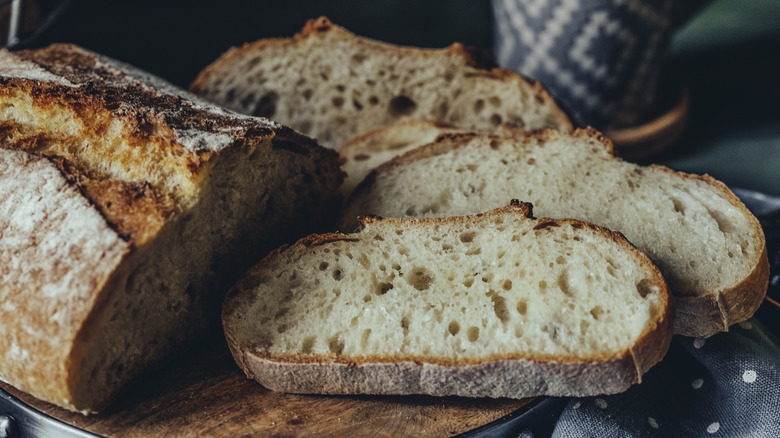When Baking Bread, Think Twice Before Swapping All-Purpose And Cake Flour
Modern all-purpose flour was a blessing for bakers everywhere when it was first invented in the 1930s. You can use it for baking bread and cakes, as well as whipping up pasta, or creating a perfect roux. It's no wonder that it's a staple in kitchens worldwide. But, because it's a go-to ingredient for so many recipes, it's often the first type of flour to disappear from your pantry.
If you need to whip up a batch of fresh bread and find yourself out of all-purpose flour, resist the urge to reach for the cake flour container. While you can swap the two in many baking recipes on a 1:1 basis, breads are a different story.
At a molecular level, cake flour and all-purpose flour are distinct. Cake flour has a protein content of 7% to 9%, which is lower than the 10% to 12% in all-purpose flour. When it comes to bread-making, high-protein flour like the all-purpose variety is the go-to choice because it contains more gluten, which will give you that fluffy, airy texture and lovely chew of well-made bread. On the other hand, cake flour is preferred for making pastries and cakes due to its lower gluten content, resulting in a finer, more crumbly texture — great for vanilla loaf cake, but the total opposite of what you'd want in your French bread loaves.
What are the best types of flour for making breads?
For the absolute best bread, you'll want to opt for bread flour. It has an even higher protein content (12% to 14%) than all-purpose. Loaves made with bread flour are more elastic and rise better than those made with any other flour. And it's not limited to bread alone — it's the top choice for yeasted baked goods in general. The gluten network traps the gas produced by the yeast during fermentation, allowing the dough to rise and maintain its shape better, which is perfect for fresh-baked sourdough.
Another option to consider is 100% whole-wheat flour. It's as close to natural flour as you can get, containing every part of the wheat berry, from the bran to the germ. Whole-wheat flour has a very high protein content, reaching up to 16%. But there's bad news if you're hoping for exceptionally fluffy bread: Because whole-wheat flour isn't finely ground, the outer layer of the grain, known as hulls, can hinder the formation of the stretchy gluten network, resulting in denser and tougher bread. Nevertheless, the nutty flavors and greater nutritional and fiber content (according to the USDA) are more than worth the rougher texture.
Thankfully, if you love whole-wheat, you can still get fluffy bread with white whole-wheat flour. It's milder and sweeter in taste, with a lighter color, yet it preserves all the nutrients of regular whole-wheat. Plus, its lower 12% protein content delivers a texture that's virtually indistinguishable from white-flour breads.

